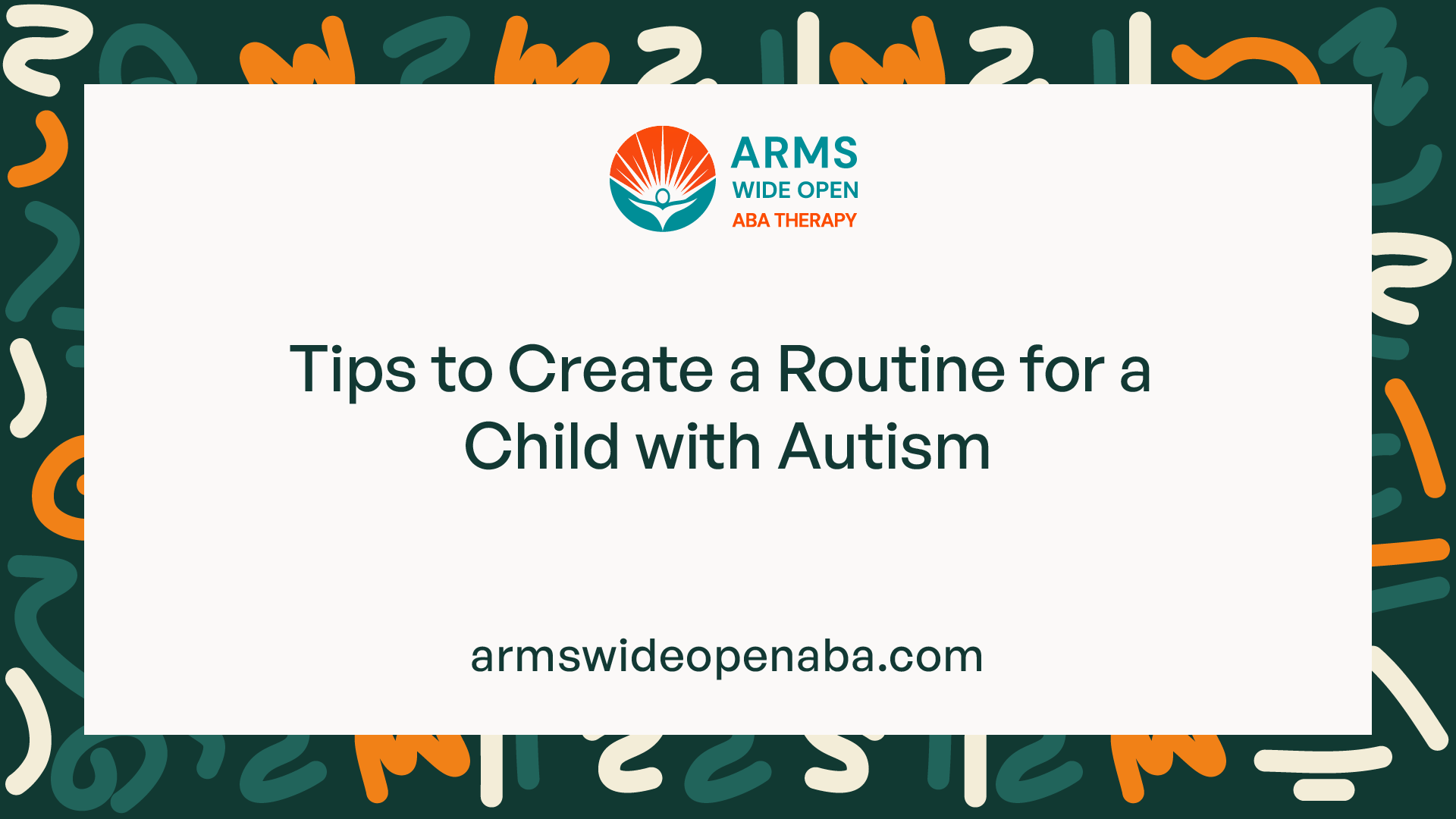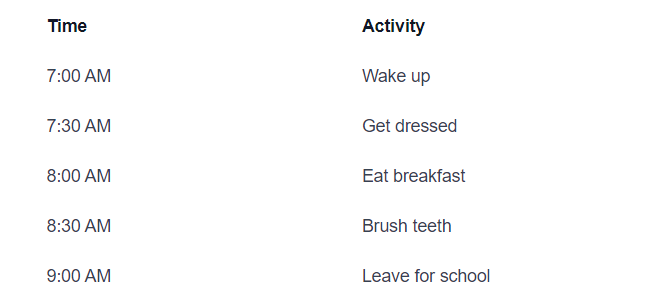Tips to Create a Routine for a Child with Autism
Unlock stability for your child with autism through proven routine tips. Foster predictability, communication, and collaboration for success.

Understanding Autism and the Importance of Routine
In order to effectively create a routine for a child with autism, it is crucial to understand what autism is and why routine plays a significant role in supporting children with this condition.

What is Autism?
Autism, also known as Autism Spectrum Disorder (ASD), is a neurodevelopmental disorder that affects communication, social interaction, and behavior. It is characterized by a range of challenges, including difficulties in social communication, restrictive and repetitive behaviors, sensory sensitivities, and difficulty with transitions and changes.
Autism is a spectrum disorder, which means that it can manifest differently in each individual. While some children with autism may have difficulties with verbal communication, others may struggle with social interactions or exhibit repetitive behaviors. It is important to recognize and respect the unique needs and strengths of each child with autism.
The Benefits of Routine for Children with Autism
Routine plays a crucial role in the lives of children with autism. It provides a sense of stability, predictability, and security, which can help reduce anxiety and support their overall well-being. The benefits of routine for children with autism include:
- Reduced Anxiety: Children with autism often find comfort in familiarity and predictability. Having a consistent routine can help reduce anxiety by providing a structured environment and clear expectations.
- Improved Understanding: Routine helps children with autism understand what is expected of them in different situations. It provides a framework for learning and can enhance their understanding of time, sequencing, and cause-and-effect relationships.
- Enhanced Communication: A consistent routine can facilitate communication between children with autism and their caregivers. It provides opportunities for practicing social skills, using visual supports, and establishing clear communication channels.
- Improved Transitions: Children with autism often struggle with transitions and changes in their environment. A well-established routine with strategies for smooth transitions can help ease the stress and anxiety associated with these changes.
By understanding the unique challenges faced by children with autism and recognizing the benefits of routine, we can create a supportive and structured environment that promotes their development and well-being. The following sections will delve deeper into strategies for creating a routine that can benefit children with autism.
Creating a Structured Environment
When it comes to supporting a child with autism, creating a structured environment is essential for their well-being and development. A structured environment provides predictability, stability, and a sense of security for children with autism. In this section, we will explore two key strategies for creating a structured environment: establishing a daily schedule and setting clear expectations and rules.
Establishing a Daily Schedule
A daily schedule plays a crucial role in providing a framework for a child with autism. It helps them understand what activities or tasks are expected throughout the day, reducing anxiety and uncertainty. When creating a daily schedule, consider the following tips:
- Consistency: Maintain a consistent routine by having a set wake-up time, mealtimes, and bedtime. Consistency helps create a sense of familiarity and stability.
- Visual Representation: Use visual supports, such as visual schedules or charts, to help your child understand and follow the daily routine. Visual schedules provide a visual representation of the activities and can be customized to meet your child's specific needs.
- Include Transition Times: Incorporate transition times between activities to allow for smoother transitions. These transition times can be indicated in the schedule to provide a visual cue for your child.
- Flexibility: While consistency is important, it's also crucial to allow for some flexibility in the schedule. This flexibility can accommodate unexpected events or changes while still maintaining a structured environment.
To further illustrate the benefits of a daily schedule, here is an example of a visual schedule for a child with autism:

Setting Clear Expectations and Rules
In addition to a daily schedule, setting clear expectations and rules helps provide structure and guidance for a child with autism. Clear expectations and rules promote understanding, reduce anxiety, and establish appropriate behavior. Here are some tips for setting clear expectations and rules:
- Simplicity: Keep rules simple and concise, using clear language that your child can understand. Avoid ambiguous or abstract terms and focus on specific behaviors or actions.
- Visual Cues: Use visual supports, such as visual reminders or social stories, to reinforce the rules and expectations. Visual cues can help your child remember and follow the rules consistently.
- Consistency: Be consistent in enforcing the rules across different settings and caregivers. This consistency helps your child understand that the rules apply in various situations.
- Positive Reinforcement: Use positive reinforcement techniques, such as praise or rewards, to encourage and reinforce desired behaviors. Celebrate your child's successes and progress.
By establishing a daily schedule and setting clear expectations and rules, you can create a structured environment that supports your child with autism. Remember to tailor these strategies to your child's individual needs and preferences, as every child with autism is unique.
Visual Supports for Routine
Children with autism often thrive in structured environments that provide clear visual cues to help them understand and navigate their daily routines. Visual supports, such as visual schedules and timers, play a crucial role in creating a predictable and organized routine for children with autism.
Visual Schedules
Visual schedules use visual cues, such as pictures, icons, or words, to outline the sequence of activities throughout the day. These schedules provide a visual representation of what is expected and help children with autism understand and anticipate upcoming events. Here is an example of a visual schedule for a morning routine:

Visual schedules can be customized to meet the specific needs of each child. They can be placed in a prominent location, such as on a wall or a whiteboard, to serve as a visual reference throughout the day. By following the visual schedule, children with autism gain a sense of predictability and structure, which can help reduce anxiety and improve their overall behavior.
Visual Timers
Visual timers are another helpful tool for children with autism to understand the passage of time and manage their activities. These timers provide a visual representation of time using colors, numbers, or a combination of both. By utilizing visual timers, children can better understand the duration of an activity and prepare for transitions.
For example, a visual timer can be set for 10 minutes to indicate the time remaining for a specific task or activity. As the time elapses, the color or the numbers on the timer gradually change, providing a clear visual indication of the passing time. This helps children with autism prepare for upcoming transitions and adjust their behavior accordingly.
Visual timers can be used independently or in conjunction with visual schedules to enhance routine comprehension and time management skills. They can be helpful during activities such as completing homework, taking turns during playtime, or transitioning between different tasks.
By incorporating visual supports like visual schedules and timers, parents and caregivers can create a structured and predictable routine that supports the needs of children with autism. These visual cues provide a clear and tangible representation of time and activities, promoting a sense of stability and understanding.
Strategies for Smooth Transitions
When creating a routine for a child with autism, smooth transitions are key to maintaining stability and reducing anxiety. Transitioning from one activity to another can be challenging for children with autism, but there are strategies that can help make the process easier. Two effective strategies for smooth transitions are using transition objects and providing transition warnings and cues.
Transition Objects
Transition objects are items that can provide comfort and familiarity during transitions. These objects can help children with autism feel more secure and prepared for the change in activity. Transition objects can be anything that holds significance for the child, such as a favorite toy, a small blanket, or a picture. The purpose of these objects is to provide a sense of continuity and reassurance during the transition.
Examples of Transition Objects
Favorite stuffed animal
Comforting blanket
Personalized keychain
By allowing the child to have access to their transition object during the transition, it can help them feel more at ease and make the transition smoother.
Transition Warnings and Cues
Providing transition warnings and cues is another effective strategy to prepare a child with autism for upcoming changes. Transition warnings involve giving the child a heads-up before the transition occurs. This can be done by using verbal prompts, visual cues, or a combination of both. For example, you can use a timer or a visual countdown to indicate how much time is left before the transition.
Examples of Transition Warnings and Cues
Verbal reminder ("In five minutes, we will clean up and move to the next activity.")
Visual timer or countdown
Picture schedule showing the upcoming activity
Using consistent and clear transition warnings and cues helps the child anticipate the change and mentally prepare for it. This reduces the likelihood of resistance or frustration during the transition.
By incorporating transition objects and providing transition warnings and cues, you can help create a smoother transition experience for a child with autism. These strategies promote a sense of predictability and security, which are essential for maintaining a structured routine. Remember to tailor these strategies to the specific needs and preferences of the child, as each individual with autism is unique in their response to transitions.
Incorporating Predictability and Flexibility
When creating a routine for a child with autism, it is important to strike a balance between predictability and flexibility. While the predictability of a routine provides a sense of stability for the child, allowing for flexibility and adaptation can help accommodate unexpected changes. Let's explore two key aspects of incorporating predictability and flexibility into a routine for a child with autism: consistency in routine and allowing for flexibility and adaptation.
Consistency in Routine
Consistency is crucial when establishing a routine for a child with autism. Maintaining a consistent schedule helps the child feel secure and reduces anxiety by providing a predictable framework for their day. Consistency can be achieved by:
- Setting fixed times for meals, activities, and daily routines.
- Using visual supports, such as visual schedules, to reinforce the sequence of events.
- Providing clear and consistent instructions for each activity.
- Encouraging family members, caregivers, and teachers to follow the routine consistently.
By maintaining consistency in the child's routine, you can help create a stable and structured environment that promotes their well-being and development.
Allowing for Flexibility and Adaptation
While routine and predictability are important for children with autism, it is equally important to allow for flexibility and adaptation. Life is full of unexpected changes, and teaching a child to be adaptable can help them navigate new situations more effectively. Here are some strategies to promote flexibility and adaptation within the routine:
- Prepare the child for changes by using visual supports to communicate any modifications to the routine in advance.
- Gradually introduce and expose the child to new experiences and environments to expand their comfort zone.
- Encourage problem-solving and decision-making skills to help the child adapt to unexpected circumstances.
- Be open to making necessary adjustments to the routine when required, taking into account the child's specific needs and preferences.
By incorporating flexibility into the routine, you can empower the child to cope with changes and develop essential life skills that will benefit them in the long run.
By striking a balance between predictability and flexibility, you can create a routine that provides stability while also allowing for growth and adaptation. Remember that every child with autism is unique, so it's important to tailor the routine to their individual needs. Regular communication and collaboration with teachers, therapists, and family members can help ensure that the routine is effective and supports the child's overall development and well-being.
Collaboration and Communication
When creating a routine for a child with autism, collaboration and communication play a crucial role in ensuring the effectiveness and success of the routine. By involving the child in routine planning and collaborating with teachers and therapists, you can create a supportive and tailored routine that meets the unique needs of the child.
Involving the Child in Routine Planning
Involving the child in the planning process can empower them and provide a sense of ownership over their routine. This involvement helps the child understand and anticipate what is expected of them, reducing anxiety and promoting a sense of control. Here are some ways to involve the child in routine planning:
- Visual representation: Use visual supports such as picture cards or visual schedules to engage the child in understanding the sequence of activities in their routine. Encourage the child to actively participate in arranging and organizing these visual representations.
- Choice-making: Offer the child choices within the routine to foster a sense of autonomy and independence. For example, allow them to choose between two preferred activities during a specific time slot.
- Communication channels: Establish open lines of communication with the child, encouraging them to express their preferences, concerns, or any difficulties they may be experiencing. This communication can take various forms, including verbal, non-verbal, or through the use of assistive communication devices.
Collaboration with Teachers and Therapists
Collaborating with teachers and therapists is essential to ensure consistency and continuity across different environments. By sharing information and strategies, you can create a unified approach to routine planning and implementation. Here are some ways to collaborate effectively:
- Regular meetings: Schedule regular meetings with teachers and therapists involved in the child's education and therapy. These meetings provide an opportunity to discuss the child's progress, share insights, and align strategies to support the child's routine.
- Sharing resources: Share visual supports, schedules, and any relevant information about the child's routine with teachers and therapists. This helps create a consistent experience for the child across different settings.
- Collaborative problem-solving: Work together with teachers and therapists to address any challenges or obstacles that may arise during the implementation of the routine. Collaborative problem-solving ensures that everyone involved is on the same page and can provide necessary support to the child.
Collaboration and communication are key components in creating a routine that promotes stability and supports the unique needs of a child with autism. By involving the child in routine planning and collaborating with teachers and therapists, you can create a cohesive and supportive environment that empowers the child and enhances their overall well-being.
Sources
https://spectrumofhope.com/blog/create-routine-for-kids-with-autism/
https://getgoally.com/blog/how-to-create-an-autism-daily-routine/
https://www.marcus.org/autism-resources/autism-tips-and-resources/establishing-routines-at-home
Similar articles
We’re here to help you

Our team is here to assist you in this process. Contact us for any assistance.
it’s easy to apply
We Accept Most Insurances
Our in-network insurance partnerships make ABA therapy more accessible to families throughout our service areas.







Our Insurance Process
We'll request your insurance details to help us verify your plan's coverage for ABA therapy. Once we've received this information, we'll walk you through your benefits, including copayments, deductibles and out-of-pocket maximums, so you know what to expect in advance.
Our team will then handle the preauthorization and all the necessary paperwork.
.svg)





















.jpeg)


































.jpeg)




.jpeg)







.jpeg)











.jpeg)
















